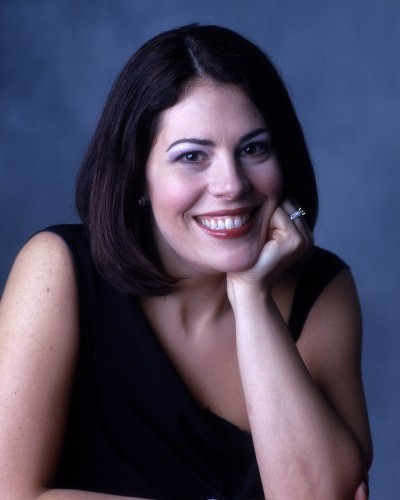On tonight's show:
Boulder Philharmonic
Charley talks with music director Michael Butterman about the Boulder Philharmonic's season finale tomorrow, followed by an all-Mozart program from the Orchestra.
Wolfgang Mozart:
Contradances, K. 609 Nos. 3 & 4
Aria, "Vedrai carino" from Act II of Don Giovanni, K .527
Aria, "L'amerò sarò costante" from Act II of Il Re Pastore, K .208
Violin Concerto No. 5 in A major, K .219 (Turkish)
Michael Butterman, conductor
Adriana Zabala, mezzo soprano
Bonnie Draina, soprano
Brian Lewis, violin
recorded 11/1/08
Opera Colorado
Charley talks with soprano Sondra Radvanovsky, who sings the title role in Opera Colorado's production of Puccini's Tosca, which opens tomorrow.
Giacomo Puccini: Aria, "Vissi d'arte" from Act II of Tosca
Moscow Chamber Orchestra
Constantine Orbelian, conductor
Sondra Radvanovsky, soprano
Telarc pre-release
Venice Baroque Orchestra
Charley talks with members of the Venice Baroque Orchestra about their epic journey to the Friends of Chamber Music concert last night.
Wolfgang Amadeus Mozart (1756-1791)
Aria, “Vedrai carino” from Act II of Don Giovanni, K. 527
After the success of The Marriage of Figaro in Prague, Mozart was commissioned to write a new opera by Pasquale Bondini, whose company had only recently been saved from bankruptcy by Figaro in 1787. Mozart's librettist for Figaro, Lorenzo da Ponte, suggested the subject of Don Juan.
Mozart worked on the music during the spring and summer of 1787, but Don Giovanni was still unfinished when he and his wife Constanze left Vienna in late August. Staying with friends in Prague, they enjoyed a rare vacation, with good food, good company, and numerous games of darts and skittles. Mozart even worked on the opera occasionally, out in the garden.
There is a darling legend about Mozart writing the Overture the night before the premiere, with Constanze by his side supplying cups of punch and telling him silly stories to keep him awake, and the orchestra sight-reading the music before the ink was dry. More likely, Mozart wrote it on October 27, the night before the last dress rehearsal.
Don Giovanni was finally given on October 29, 1787 to enormous acclaim. One account mentioned that “the whole powers of both actors and orchestra were put forward to do honor to Mozart.” The impresario sent Da Ponte a note: “Long live Da Ponte, long live Mozart. Every impresario and singer should bless them. As long as they live the theater can never again fall on hard times.”
In the second act, Zerlina comforts her fiance Massetto, who has just been beaten up by Don Giovanni.
“L'amerò, sarò costante” from Act II of Il Re Pastore, K. 208
Shortly after his return to Salzburg from the Munich production of La Finta Giardiniera, K.196, Mozart was commissioned to write another opera, this time by his own employer, the Archbishop Colloredo. The occasion was a visit to Salzburg of the Empress Maria Theresia's youngest son, the Archduke Maximilian Franz.
Mozart had barely a month an a half to complete the work, which is sometimes called a cantata, a pastorale or a dramatic serenade. He selected a well-worn text by the Viennese court poet Pietro Metastasio titled Il Re Pastore (The Shepherd King). It had been set by at least twelve other composers, including Giuseppe Bonno at the first performance in 1751 and later by Gluck. The first performance of Mozart's Il Re Pastore was given on April 23, 1775 with the famous castrato Consoli in the title role.
In the second act, the shepherd Aminta--who is the righful heir to the throne--sings of his love for the nymph Elisa. In his book on Mozart's operas, Charles Osborne describes the aria as “a rondo in five sections, an andantino of great beauty and tender feeling, and the emotional climax of the opera.”
The score calls for soprano, solo violin, 2 flutes, 2 English horns, 2 bassoons, 2 horns and strings.
Text of “L'amerò, sarò costante”
L'amerò, sarò costante,
fido sposo e fido amante,
sol per lei sospirerò.
In sì caro e dolce oggetto
la mia gioia, il mio diletto,
la mia pace io troverò.
Translation:
I will love her, I will be faithful,
a faithful husband and faithful lover.
I shall sigh only for her.
In her, so precious and sweet a thing,
my joy, my delight,
my peace will I find.
Violin Concerto No. 5 in A major, K. 219 (Turkish)
I. Allegro aperto
II. Adagio
III. Rondeau: Tempo di menuetto
“You have no idea how well you play the violin,” wrote Mozart's father to his son. “If only you would do yourself justice and play with boldness, spirit and fire, you would be the first violinist in Europe.”
Within a period of nine months in 1775, Mozart wrote five violin concertos, either for his own use as concertmaster of the Salzburg orchestra, or for his successor in the post, Antonio Brunetti. The fifth of the set was finished on December 20. It is subtitled Turkish because of the so-called “Turkish music” in the last movement, which Mozart lifted from his own opera Lucio Silla.
Alfred Einstein considers the Fifth Concerto “unsurpassed for brilliance, tenderness and wit.” Describing all five violin conertos, H.C. Robbins Landon writes: “Melody is piled upon melody, and new ideas succeed each other in blissful insouciance of each other and of any strict formal pattern. What immediately captivates the listener is the matchless elegance of conception and execution, the suavity of orchestration--which even at this comparatively early stage has that natural brilliance which is so characteristic of mature Mozart--and the luxurious delight in pure melody.”
The score calls for solo violin, 2 oboes, 2 horns and strings
©2010 Charley Samson
